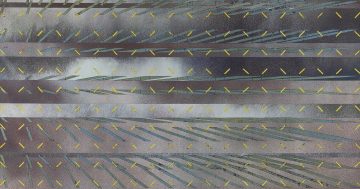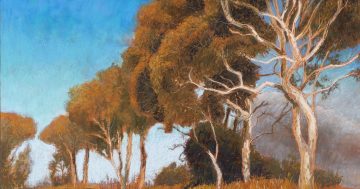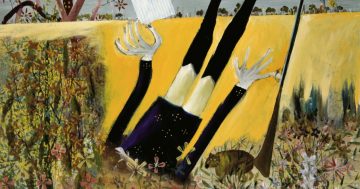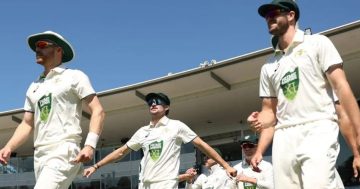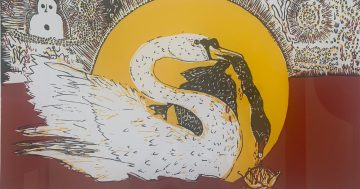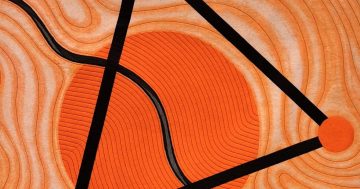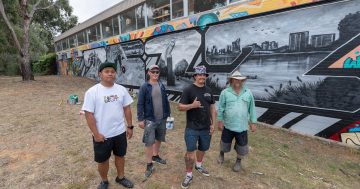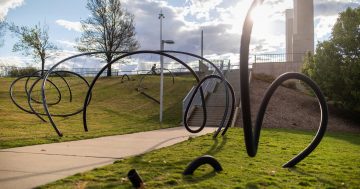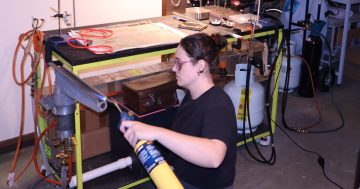
Richard Larter, Bath Night I, 1963, alkyd and polymer resins on particle board, 122 × 183 cm. Hassall Collection, Gadigal Land, © The Estate of Richard Larter. Photo: Drill Hall Gallery.
The Larters – Richard Larter (1929-2014) and Pat Larter (1935-1996) – have loomed large in the Canberra art scene for many decades.
Born in Britain, the Larters married in 1953 and migrated to Australia in 1962 where they settled in Sydney for 20 years. They moved to Yass in 1982, and after Pat died in 1996, Richard moved to Canberra, where he spent the remaining years of his life.
Tony Oates, the curator of this exhibition and the author of a major essay in the accompanying catalogue, termed Larter’s work as that of a ‘Free Radical’.
Richard Larter – a teacher by profession and an exceptionally articulate artist – created a narrative for his art. Throughout, Larter emphasised that it was the responsibility of the artist to reward the freedom that he has inherited by challenging the values espoused by our capitalist society. It was the artist’s duty to challenge the ethical values, to expose the hypocrisy of the leaders and to denounce the double standards held by those in office.
A hallmark of Larter’s paintings and collages is highly sexualised imagery – mainly women in explicit poses, images of oral sex and women in states of orgasm.
For most of the 43 years of marriage, it was Pat Larter, a performance artist in her own right, who was the Muse and model in his art. It has been argued, in part convincingly, that Pat was not a passive model adopting the poses invented by her husband artist, but she invented them herself and in a way steered his work.
Hester Gascoigne, in an essay in the catalogue, wrote of “Pat’s capacity to express herself in Richard’s paintings”. Early paintings, including Bath Night I, 1963, may be interpreted as Larter playing with a tradition in Western art of paintings of women bathing.
By the time he painted Gesetz und ordnung (Law and Order), 1972, the sexualised images of Pat, as a beacon of hope, are juxtaposed with images of evil, including those of Heinrich Himmler and J Edgar Hoover. The collage-like surface of the painting is broken up by fields of abstracted colour.
In the 1970s, many of his paintings, including The Identity That Was Almost, 1972, created a somewhat dense, rippling surface tapestry of images and colours where libidinal energy was the power for good while the suited, almost all-male elite, represented the powers of darkness. This became Larter’s signature style, and the fledgling Australian National Gallery in Canberra was the first public collection to buy one of his paintings in 1970.
Curators, art critics and art directors have generally lionised his work, and from 1972, Larter could give up teaching and survive by selling his art. In 2008, Deborah Hart curated an excellent and comprehensive retrospective exhibition of Larter’s work at the National Gallery of Australia in Canberra. Over the years, we have been somewhat over-exposed to Larter’s work – especially in the nation’s capital.
Larter, in some of his earlier paintings, applied the paint with a hypodermic syringe that gave him a dancing line that he could control. Later, he would use mini sponge rollers dotted with paint, which he could employ to create vibrant patterns.
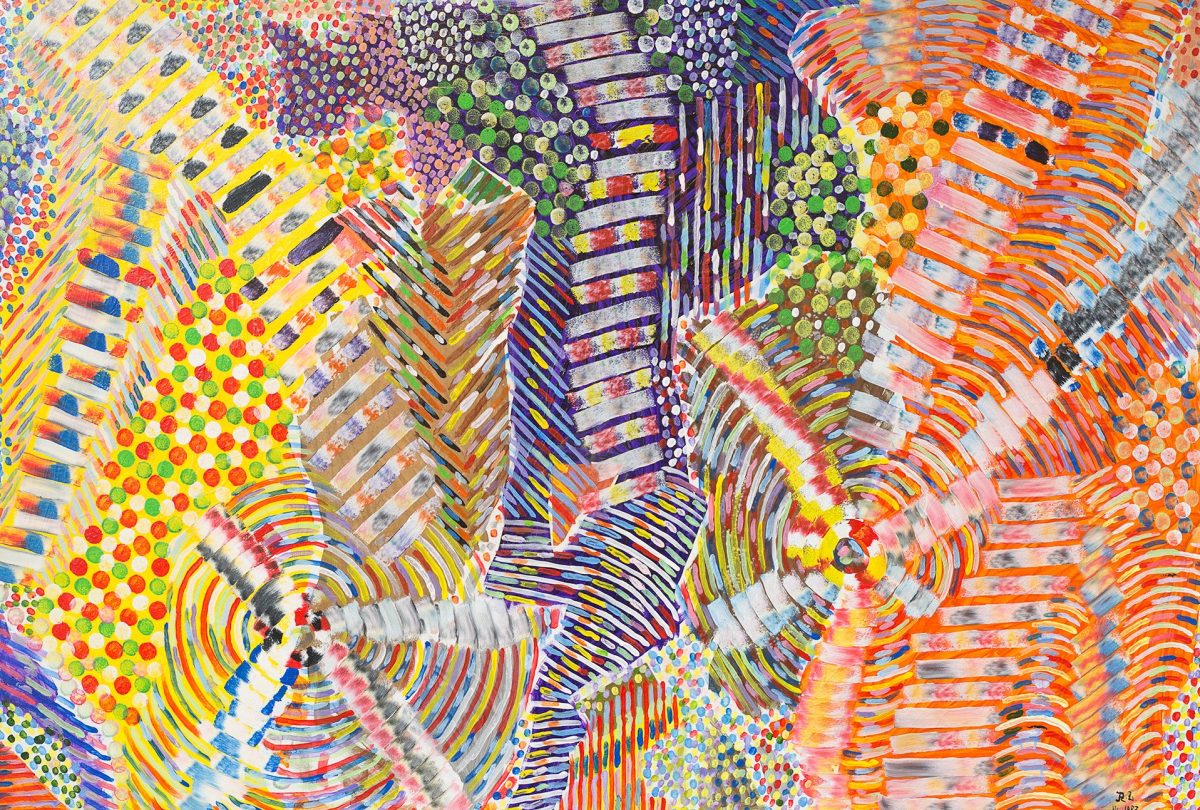
Richard Larter, Composition No.2, 1988, acrylic, pigments, gold and bronze powders with acrylic fixative, oil crayon, collaged metallic paper, 123 × 184 cm. Hassall Collection, Gadigal Land, © The Estate of Richard Larter. Photo: Drill Hall Gallery
A decade after his death, how are we to assess Larter’s art?
When I first encountered it in the late 1970s, I had just returned from study in Europe, where I had experienced the full flowering of eroticised pop art. I did not see anything particularly exceptional in Larter’s work, but it possibly was quite unusual in the Australian art scene.
Was Richard Larter the father of Australian pop art? He shrugged off claims of paternity and was unhappy with the pop art tag. I think Mike Brown, Martin Sharp and even Brett Whitely, in some of their Sydney work, predated Larter and had a purer pop art sensibility. The Larters created a unique, seductive and subversive synthesis in their art that certainly stirred the possum in the Sydney and Canberra art scene. It was highly eroticised and politicised and had a considerable impact on some artists, including Peter Maloney and Derek O’Connor, as demonstrated in the Drill Hall exhibitions.
Visitors to the Drill Hall encounter this advice at the entrance: “This exhibition contains nudity. Visitors may wish to preview this exhibition via the catalogue available at the front desk.” On reading this, I could feel Dick and Pat Larter grinning from above.
Richard Larter: Free Radical and Riffing On: Pat Larter’s Rhythms and Peter Maloney’s Blues is at ANU Drill Hall Gallery, Kingsley Street, Acton, from 8 November to 19 January 2025, from Wednesday to Sunday from 10 am to 5 pm.












